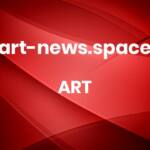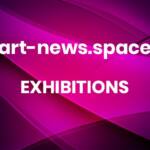It’s surprising that, even though quantum theory is now officially over 100 years old, so few people truly understand it. That’s not a failing of the public—it’s just that quantum mechanics demands a kind of mental flexibility we don’t often use.
To accept that particles can be entangled across vast distances, or that matter can exist in multiple states at once, all that challenges the classical sense of reality that we’ve grown accustomed to: that things are one way, or they’re another. Quantum theory insists: they can be both.
And yet, as the filmmaker Chris Marker once said, “Rarely has reality needed so much to be imagined.” Doesn’t that feel especially true today?
In this, Laure Prouvost has given me some faith. After stepping out from the near-total darkness of her exhibition “We Felt a Star Dying,” commissioned by LAS Art Foundation, shown in the cavernous Kraftwerk Berlin, I felt I had glimpsed something in her oscillating installation: a possibility of a new artistic era, one accelerated and liberated by quantum computing and its theory. While so much of contemporary art has been whittled down into digestible bites—something easily tidied into a press release or sales pitch—here was a work that resisted categorization, one that seemed to bloom in ambiguity.
Laure Prouvost, WE FELT A STAR DYING 2025. Installation view at Kraftwerk Berlin. Commissioned by LAS Art Foundation and co-commissioned by OGR Torino. © 2025 Laure Prouvost. Photo: Andrea Rossetti © VG Bild-Kunst, Bonn 2025
Prouvost is known for sowing a bit of mischief into her projects, which suits the unpredictable nature of quantum technology well. The French conceptual artist, who some have called an artist-cum-trickster, has tried to fold time and space before; she told everyone she was digging a tunnel between the British and French pavilions when she represented France in 2019. Prouvost has played with the notion of new forms of intelligence—several projects incorporate octopuses, works that encompassed her fascination with the creature’s embodied intellect and otherworldliness.
While artificial intelligence is well-known by now as a new material for artists, quantum computing qubits, the fundamental units of a quantum computer, are an exciting and lesser-known tool that can alter and expand work in manifold ways. Quantum computers process information using qubits, units that can exist in a state of both 0 and 1 simultaneously (called superposition), and which can be connected over long distances (entanglement). These are a good match for Prouvost, who uses them as a creative sparring partner.
Before you see her new multipart work, which manifests as an ever-changing iridescent cascading fabric installation, swelling and sinking against the concrete parameters of Kraftwerk, you hear it. It sounds like it is breathing. What was one of the final touches is one of its most crucial in bringing vitality to the installation, which can best be described simultaneously as a machine, an environment, and a creature.
Laure Prouvost, WE FELT A STAR DYING 2025. Installation view at Kraftwerk Berlin. Commissioned by LAS Art Foundation and co-commissioned by OGR Torino. © 2025 Laure Prouvost. Photo: Andrea Rossetti © VG Bild-Kunst, Bonn 2025
At the central “brain” of this installation is a film, which you lie down on a soft pillow-like half womb and gaze up at. Technically speaking, what you see is what Prouvost calls a “Newtonian film” recording that was fed into a quantum computer, which introduced indeterminate variations to the edit and its imagery.
This makes the film less fixed—a quality that feels aligned with the ways good art should behave, at least in my view. is fluid, shifting, resistant to a singular interpretation, or even viewing. As viewers lie down they watch mitochondria kiss, a cat walks across the camera lens, though another time it is a bird. Worms move about in soil, and limbs of dancers replicate, twist, merge, and tremble as if they were turned into light and shot through a kaleidoscope. I went twice; it was never quite the same. Patterns emerge that appear like thermal maps. The quantum warps are most basically described as visual effects, but the edits and chronology of the film itself are also warped, as is the coordination of the kinetic installation around you. Prouvost’s own voice is what seems most continuous. A delicate and melodic French accent guides us towards the ideas of everything being everything, and everything being quantum.
Laure Prouvost, We Felt a Star Dying, 2025, video still. Commissioned by LAS Art Foundation and co-commissioned by OGR Torino. © 2025 Laure Prouvost. © VG Bild-Kunst, Bonn 2025
But this is a work that does not simply draw from quantum theory or attempt to explain its science—it reawakens artistic questions about perception, instability, and interpretation instead. Prouvost’s installation, developed in collaboration with philosopher Tobias Rees and Hartmut Neven (head of Google’s Quantum A.I. lab), is technically ambitious, but more importantly it is deeply sensorial. It disarms you the right amount so that you can the idea, not rationally understand it (though LAS does have an extensive learning center for that). With “We Felt a Star Dying,” it is not about harnessing a quantum computer or knowing how it works and what it can do (though that is also an effect)—it’s about trying to push viewers to feel the boundaries being redrawn.
The musician John Cage, cited by Prouvost’s audio and visual team as an influence, named a process called “chance operations,” a way to feed natural randomness into the artistic process so as to surrender control, to resensitize both the artist and viewer. Quantum mechanics and computing, with its inherent refusal of binaries and a needed embrace of uncertainty and speculation, feels like an echo of that same impulse. It offers a way out of the overly legible, the tidily framed, over-marketed condition much of contemporary art finds itself in.
Laure Prouvost, , 2025, video still. Commissioned by LAS Art Foundation and co-commissioned by OGR Torino. © 2025 Laure Prouvost. © VG Bild-Kunst, Bonn 2025
The exhibition of Prouvost launches LAS’s Sensing Quatum program, which will include further installations, a symposium, and a sound lab across this year and in 2026. Unlike A.I., which, if it follows the input rules, produces mimetic results, quantum computing systems produce an ambiguous outcome. These curious systems offer a way to reintroduce strangeness, intuition, and uncertainty into artistic processes—qualities long championed by artists. Cage said: “The function of art is to imitate nature in her manner of operation.” In other words, art should reflect the chaos, unpredictability, and multiplicity of the universe itself.
And while access to quantum computing is still limited—there are only about a hundred worldwide, adding to the monumentality of this show—the conceptual shift they represent is here. Even without physical machines, artists are working with the metaphors and symbolisms they offer. What could art look like if it fully embraced that? If we could build as second nature the notion that nothing is ever just one thing; that everything is not an “and/or” dichotomy, but a “both and” widening of a viewpoint. To truly feel that everything is connected. Imagine reality—and society—with this kind of spirit at hand. There is something to be excited about.



